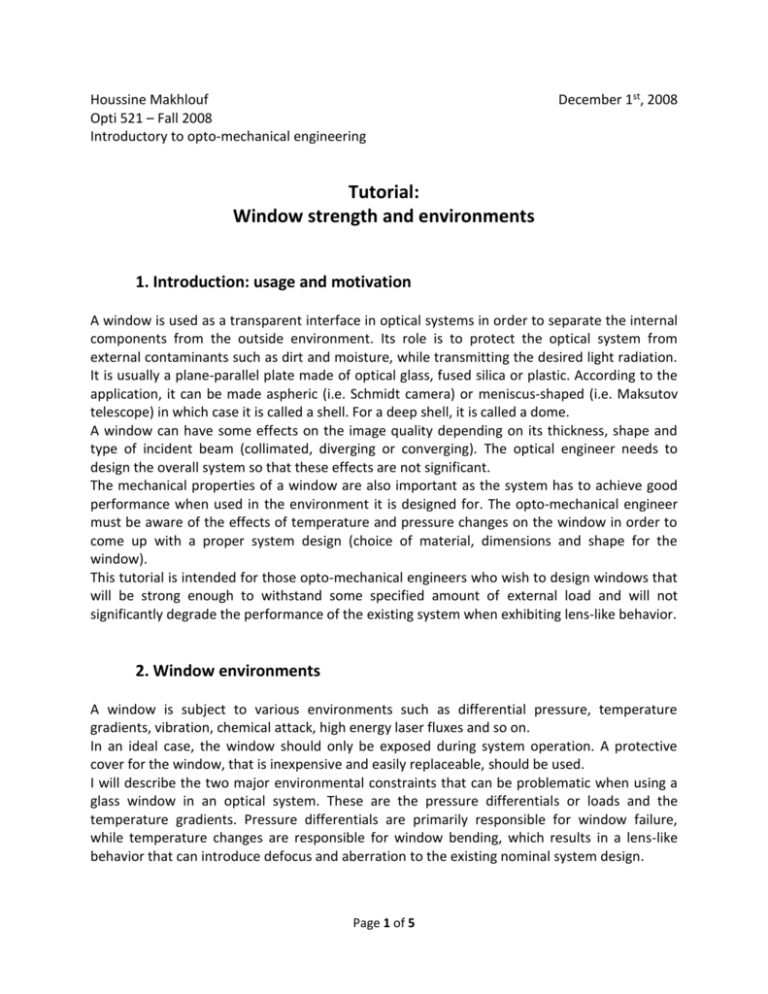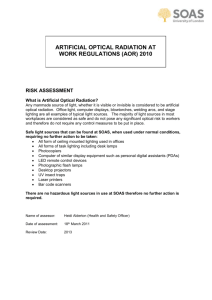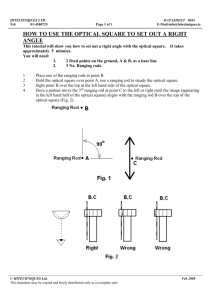Window strength and environments
advertisement

Houssine Makhlouf Opti 521 – Fall 2008 Introductory to opto-mechanical engineering December 1st, 2008 Tutorial: Window strength and environments 1. Introduction: usage and motivation A window is used as a transparent interface in optical systems in order to separate the internal components from the outside environment. Its role is to protect the optical system from external contaminants such as dirt and moisture, while transmitting the desired light radiation. It is usually a plane-parallel plate made of optical glass, fused silica or plastic. According to the application, it can be made aspheric (i.e. Schmidt camera) or meniscus-shaped (i.e. Maksutov telescope) in which case it is called a shell. For a deep shell, it is called a dome. A window can have some effects on the image quality depending on its thickness, shape and type of incident beam (collimated, diverging or converging). The optical engineer needs to design the overall system so that these effects are not significant. The mechanical properties of a window are also important as the system has to achieve good performance when used in the environment it is designed for. The opto-mechanical engineer must be aware of the effects of temperature and pressure changes on the window in order to come up with a proper system design (choice of material, dimensions and shape for the window). This tutorial is intended for those opto-mechanical engineers who wish to design windows that will be strong enough to withstand some specified amount of external load and will not significantly degrade the performance of the existing system when exhibiting lens-like behavior. 2. Window environments A window is subject to various environments such as differential pressure, temperature gradients, vibration, chemical attack, high energy laser fluxes and so on. In an ideal case, the window should only be exposed during system operation. A protective cover for the window, that is inexpensive and easily replaceable, should be used. I will describe the two major environmental constraints that can be problematic when using a glass window in an optical system. These are the pressure differentials or loads and the temperature gradients. Pressure differentials are primarily responsible for window failure, while temperature changes are responsible for window bending, which results in a lens-like behavior that can introduce defocus and aberration to the existing nominal system design. Page 1 of 5 Houssine Makhlouf Opti521 – Fall 2008 Tutorial Window Strength a. Effect due to load A uniform load applied to a simply supported circular window causes distortion of the window. The maximum optical path difference δ for an optical path through the window is given by: Where n is the index of refraction, ΔP is the pressure differential, E is the window Young’s modulus, d is the window diameter and h is the window thickness. The window distortion is deemed acceptable if the maximum optical path difference δ meets the Rayleigh criterion δ < λ/4 (λ is the wavelength of light). So in a given environment (that is for a given pressure differential and a given radiation), one needs to choose the window material (choice on n and E) and design the window dimensions (d and h) such that this criterion is met. If the window is subjected to acceleration loading, the equation giving the maximum optical path difference can be used by replacing the pressure differential ΔP with Where a is the acceleration, ρ is the window density and g is the Earth’s gravity acceleration. If the window is subjected to dynamic aerodynamic loading, the same equation still holds by replacing the pressure differential ΔP with Where P is the free stream air pressure and M is the Mach number (normalized velocity with respect to sound wave velocity). b. Handling the stress caused by mounts and external pressure The distortion of a window can be an important problem in an optical system. Therefore mounts should hold the window with a low level of stress. The ratio between the window thickness and the window diameter constitutes the critical parameter for a glass window subjected to external pressure. The minimum of this ratio is given by: Page 2 of 5 Houssine Makhlouf Opti521 – Fall 2008 Tutorial Window Strength Where h is the window thickness, d is the window diameter, CSF is the safety factor, Csp is the support condition constant (Csp = 0.265 for a simply supported window, Csp =0.217 for a clamped window), P is the pressure differential and σYS is the window yield strength. This equation holds for circular windows. Analogous equations to specify the dimensions of a rectangular window subjected to external pressure also exist. These depend again on the type of support for the window (simple or clamped) and can be found in Vukobratovich notes. So the dimensions of the window need to be made in a manner that is properly correlated to the external pressure, the strength of the material and the type of mount. As examples underwater systems, which experience very high pressures, have their windows preferably made of acrylic. For pressures up to 69MPa, we have h/d ≥ 1 and for pressures up to 138MPa, we get h/d ≥ 2. For external pressure insulation, three kinds of spherical domes can be used: Spherical Sector (Courtesy Vukobratovich) Hemisphere Hyper-hemisphere The stresses at a point of radial coordinate r in an externally pressurized dome are given by: Where σ1 is the meridian membrane stress, σ2 is the hoop membrane stress, σ3 is the radial wall stress, P is the external pressure, Ro is the outer dome radius and Ri is the inner dome radius. Page 3 of 5 Houssine Makhlouf Opti521 – Fall 2008 Tutorial Window Strength The critical collapse pressure PCR for failure by elastic buckling is the external pressure necessary for dome collapse. It is expressed by the following equation: Where E is the Young’s modulus, ν is the Poisson ratio, Ro is the outer dome radius and Ri is the inner dome radius. The material and shape of the dome must be chosen so that the external pressure during system operation remains well below the critical pressure PCR. A safety factor can be applied. A couple examples of material used for domes follow. For pressures up to 70MPa, one should use DuPont Fairprene 5722 and Pliobond cement. For pressures up to 275MPa, one should use two layers of Kevlar 49 cloth and epoxy resin. c. Effect due to temperature differentials Thermal gradients cause distortion within a window. As a window bends, it behaves like a lens and causes defocus and additional aberration at the image plane. Thermal gradients can be axial or radial, and exhibit different profiles (linear, parabolic…). The window optical power induced by an axial thermal gradient is given by: Where n is the index of refraction, α is the coefficient of thermal expansion, k is the thermal conductivity, h is the window thickness and q is the heat flux per unit area absorbed by the window. For instance, in the case of a BK7 window, the optical power induced by such a thermal gradient is: For best performance, one needs to minimize the unwanted optical power by making the window as thin as possible (that is decrease h) and applying a reflective coating (that is decrease q). In the presence of a parabolic radial thermal gradient, no aberration is introduced, but the induced optical power is given by: Page 4 of 5 Houssine Makhlouf Opti521 – Fall 2008 Tutorial Window Strength Where d is the window diameter, ΔT is the radial temperature difference, ν is the Poisson ratio dn/dT is the therm-optic coefficient and the other parameters are defined previously. The focal shift is reduced by using a thinner and/or larger diameter window. In general the radial temperature profile is a complex function and as a rule of thumb, radial gradient effects are practically eliminated by making the window 25% larger than the system clear aperture. 3. Conclusion When designing the window part of an opto-mechanical system, specific care should be given to the effects of the different sources of load and the temperature change. Window distortion results from these two environmental constraints and can be pretty dramatic for the image quality. On the one hand the window can fail and thus the internal components of the system could no longer be insulated from the outside environment and protected against external contaminants. On the other hand the bowed window, acting as a lens, could potentially introduce a significant amount of defocus and other aberrations. Relevant choices on the optical material (involving index of refraction, Young’s modulus, Poisson ratio, yield strength) used to make the window, as well as on the dimensions (thickness and diameter) and shape (curvature for domes) of the window must be made in correlation with the environmental constraints during system operation (temperature change, pressure differential, mount load) in order to have a withstanding window introducing a negligible amount of optical power, and thus negligible defocus and aberration, to the optical system. 4. References - P.R. Joder, Jr., Ch. 6 Mounting Windows and Filters, Opto-Mechanical Systems Design, 3rd edition, Taylor & Francis group, 2006. - D. Vukobratovich and S.M. Vukobratovich, notes “Introduction to Opto-Mechanical Design”. Page 5 of 5






